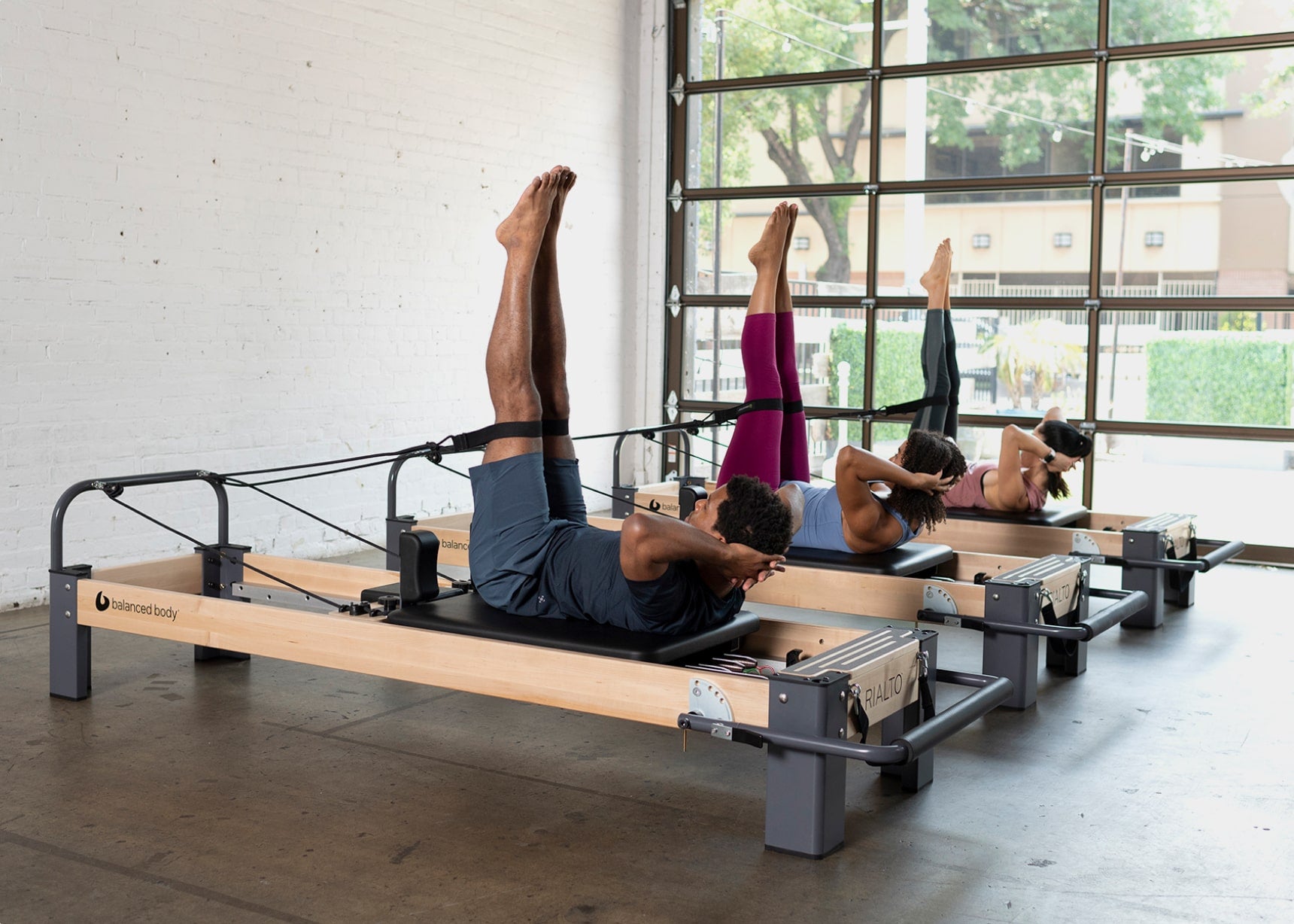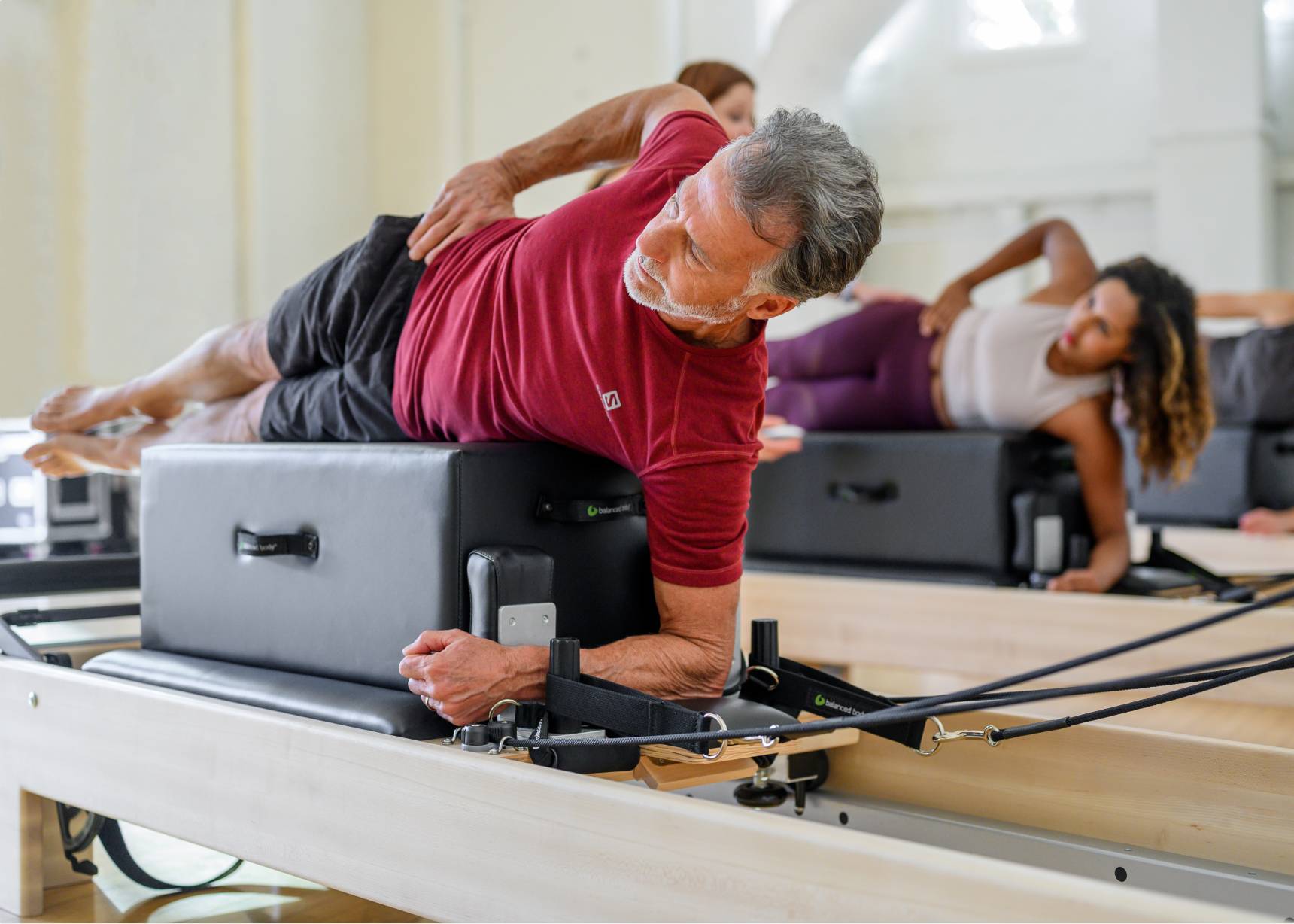The Ultimate Guide to the Pilates Reformer
The Ultimate Guide to the Pilates Reformer
Our in-depth guide to the Pilates Reformer that answers all of your questions.
By Portia Page
Education Curriculum Coordinator for Balanced Body
Welcome to the most popular and versatile piece of Pilates equipment: the Reformer! With bars and pulleys and ropes, Pilates Reformers can appear intimidating at first, especially to beginners. But this unique fitness and rehabilitation machine offers unparalleled benefits. Let’s dive in.
Jump to a Section:
- What is a Pilates Reformer?
- How does a Reformer work?
- What are the benefits of using a Reformer?
- Who can use a Pilates Reformer?
- Pilates Reformer classes
What is a Pilates Reformer?
A Pilates Reformer is a specialized piece of exercise equipment designed to enhance Pilates workouts. It consists of a flat platform (carriage) that rolls back and forth on wheels within a wood or metal frame. The carriage is attached to one end of the Reformer by a set of springs, which provide variable resistance.
In traditional mat Pilates, your body provides both resistance and assistance for each movement. A Reformer offers more exercise options since it can be adjusted to provide extra challenge or extra support. It also offers truly assistive movement, which makes it an excellent rehabilitation tool for physical therapists alongside fitness users.

How Does a Pilates Reformer Work?
The Pilates Reformer operates through a system of springs and pulleys that create resistance as the carriage moves. Users can perform a wide range of exercises by using their body weight and the springs for resistance through different types of motion and in all positions (supine, prone, side lying, seated and standing).
Components of a Reformer
- Springs: The springs provide resistance for each exercise, offering extra challenge or extra support. Adjusting the springs alters the difficulty of moving the carriage, making it versatile for various fitness levels or goals. Use a single spring or a combination of springs to adjust each exercise.
- Springbar: Springs are connected from this bar to the carriage. On some Reformers, the position of the springbar can be adjusted to accommodate users of different sizes.
- Footbar: You can push off the footbar to move the carriage and start an exercise. Footbars with adjustable positions can better accommodate different users and ranges of motion.
- Carriage: Depending on the type of exercise, you can lay, sit, kneel or stand on the carriage. Pushing off the footbar or pulling on the ropes moves the carriage smoothly along the rails. A headrest and shoulder rests attached to the carriage provide stability and comfort.
- Ropes: Reformer ropes run from the carriage through pulleys to your hands or feet. The ropes can be connected to loops or handles to help customize the grip and movement for a given exercise. Some traditional Reformers use leather straps and casters instead of ropes and pulleys.
Reformer Accessories
There are several Pilates Reformer accessories that can be used to enhance your workout:
- Sitting Box: sit or lay on a sitting box placed on the carriage to do more versatile exercises, like side stretching, prone, supine, and arm work. The Sitting Box also allows for more advanced abdominal exercises (using the foot strap as a foot hold) as well as a prop to support the back and spine in exercises like Stomach Massage.
- Jumpboard: attaching a jumpboard to the Reformer allows you to do running and jumping exercises while laying on the carriage, which is a great way to incorporate cardio and strength work into your Reformer workout.
- Tower: adding a tower to the end of the Pilates Reformer dramatically increases the exercise options without taking up additional space. The mat conversion allows the Reformer to be used as a Mat and the use of the Tower allows the versatility of springs for standing arms and leg work as well as seated work utilizing the roll down bar for seated roll backs and other more complex exercises.
- Straps, Loops & Handles: attaching straps or switching out handles and loops allows Reformer exercises to be easily customized.

Benefits of Using a Pilates Reformer
Using a Reformer takes the effectiveness and versatility of traditional Pilates to the next level. Pilates Reformer exercises help improve strength, flexibility, and balance by focusing on controlled, precise movements. The Reformer allows for a wide range of motion, which facilitates deep muscle engagement across multiple muscle groups. The result? A full-body workout that strengthens and tones muscles, with a low impact on the joints.
One major benefit of using the Pilates Reformer is enhanced core strength and improved posture, leading to better balance and coordination. This makes it an effective exercise for older adults as well as an excellent tool for injury rehabilitation.
Who Can Use a Pilates Reformer?
Almost anyone can use a Pilates Reformer! Low impact movement and adjustable resistance means that Reformer workouts are suitable for both beginners as well as advanced users. They are particularly beneficial for:
- Fitness Enthusiasts who are looking to enhance their core strength, flexibility, and overall fitness
- Pilates Beginners who are eager to reap the physical and mental benefits of Pilates
- Rehabilitation Patients who require low-impact exercises to aid in recovery and preventing future injuries
- Athletes who want to improve performance through targeted muscle conditioning and injury prevention
- Older Adults who need a safe and effective way to maintain fitness and mobility
Always consult your doctor before beginning any new exercise program

Pilates Reformer Classes
Pilates Reformer classes are typically conducted in a group setting, led by a certified instructor. These classes are structured to guide participants through a series of exercises that utilize the Reformer’s capabilities to target different muscle groups. This includes the Pilates repertoire as well as foundational movement principles and how to use fitness exercises on the Reformer.
Classes usually start with a warm-up, followed by a sequence of exercises focusing on strength, flexibility, and balance. The instructor adjusts the resistance levels and provides modifications to accommodate various fitness levels and goals. More advanced classes may include props and other tools like the Pilates chair to ramp up the workout’s impact.
Role of Certified Pilates Instructors
Certified Pilates instructors play a crucial role in the effectiveness and safety of Pilates Reformer workouts. They are trained to tailor exercises to individual needs and fitness levels, and adapt exercises for those with limitations or specific goals. By ensuring proper form and technique, Pilates instructors help maximize the benefits of the Reformer while minimizing the risk for injury. Crucially, trained Pilates teachers offer the motivation, support and expert advice that participants need to achieve their fitness goals!
About the Author
 | Portia Page is a teacher, international presenter and author and has been in the fitness industry 33 years. An Educator and the Education Curriculum Coordinator for Balanced Body, the author of Pilates Illustrated, Portia is ACE, NASM and AFAA certified, a RYT® 200 with Yoga Alliance, as well as a Nationally Certified Pilates Teacher and CEC provider through NPCP. She is also a Cancer Exercise Specialist and studied under the Cancer Exercise Training Institute (CETI). |